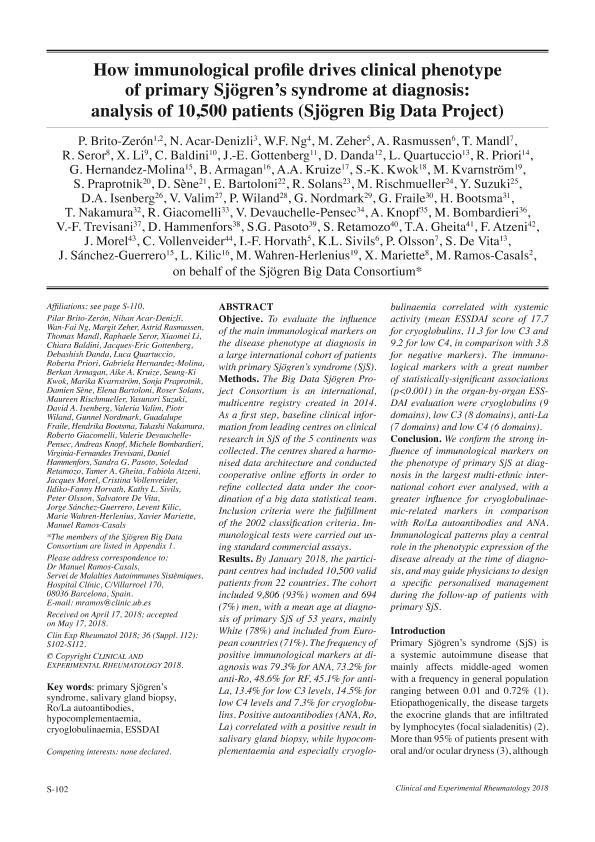Artículo
How immunological profle drives clinical phenotype of primary Sjögren’s syndrome at diagnosis: analysis of 10,500 patients (Sjögren Big Data Project)
Brito Zerón, Pilar; Acar Denizli, Nihan; Ng, Wan Fai; Zeher, Margit; Rasmussen, Astrid; Mandl, Thomas; Seror, Raphaele; Xiaolin, Li; Baldini, Chiara; Gottenberg, Jaques; Danda, Debashish; Quartuccio, Luca; Priori, Roberta; Hernandez Molina, Gabriela; Armagan, Berkan; Kruize, Aike; Kwok, Seung Ki; Kvarnström, Marika; Praprotnik, Sonja; Sene, Damien; Bartoloni, Elena; Solans, R.; Rischmueller, M.; Suzuki, Y.; Isenberg, D. A.; Valim, V.; Wiland, P.; Nordmark, G.; Fraile, G.; Retamozo, Maria Soledad

Fecha de publicación:
14/09/2018
Editorial:
Clinical & Exper Rheumatology
Revista:
Clinical And Experimental Rheumatology
ISSN:
0392-856X
e-ISSN:
1593-098X
Idioma:
Inglés
Tipo de recurso:
Artículo publicado
Clasificación temática:
Resumen
To evaluate the influence of the main immunological markers on the disease phenotype at diagnosis in a large international cohort of patients with primary Sjögren´s syndrome (SjS).METHODS:The Big Data Sjögren Project Consortium is an international, multicentre registry created in 2014. As a first step, baseline clinical information from leading centres on clinical research in SjS of the 5 continents was collected. The centres shared a harmonised data architecture and conducted cooperative online efforts in order to refine collected data under the coordination of a big data statistical team. Inclusion criteria were the fulfillment of the 2002 classification criteria. Immunological tests were carried out using standard commercial assays.RESULTS:By January 2018, the participant centres had included 10,500 valid patients from 22 countries. The cohort included 9,806 (93%) women and 694 (7%) men, with a mean age at diagnosis of primary SjS of 53 years, mainly White (78%) and included from European countries (71%). The frequency of positive immunological markers at diagnosis was 79.3% for ANA, 73.2% for anti-Ro, 48.6% for RF, 45.1% for anti- La, 13.4% for low C3 levels, 14.5% for low C4 levels and 7.3% for cryoglobulins. Positive autoantibodies (ANA, Ro, La) correlated with a positive result in salivary gland biopsy, while hypocomplementaemia and especially cryoglo-bulinaemia correlated with systemic activity (mean ESSDAI score of 17.7 for cryoglobulins, 11.3 for low C3 and 9.2 for low C4, in comparison with 3.8 for negative markers). The immunological markers with a great number of statistically-significant associations (p<0.001) in the organ-by-organ ESS- DAI evaluation were cryoglobulins (9 domains), low C3 (8 domains), anti-La (7 domains) and low C4 (6 domains).CONCLUSIONS:We confirm the strong influence of immunological markers on the phenotype of primary SjS at diagnosis in the largest multi-ethnic international cohort ever analysed, with a greater influence for cryoglobulinaemic-related markers in comparison with Ro/La autoantibodies and ANA. Immunological patterns play a central role in the phenotypic expression of the disease already at the time of diagnosis, and may guide physicians to design a specific personalised management during the follow-up of patients with primary SjS.
Archivos asociados
Licencia
Identificadores
Colecciones
Articulos(INICSA)
Articulos de INSTITUTO DE INVESTIGACIONES EN CIENCIAS DE LA SALUD
Articulos de INSTITUTO DE INVESTIGACIONES EN CIENCIAS DE LA SALUD
Citación
Brito Zerón, Pilar; Acar Denizli, Nihan; Ng, Wan Fai; Zeher, Margit; Rasmussen, Astrid; et al.; How immunological profle drives clinical phenotype of primary Sjögren’s syndrome at diagnosis: analysis of 10,500 patients (Sjögren Big Data Project); Clinical & Exper Rheumatology; Clinical And Experimental Rheumatology; 36; 3; 14-9-2018; 112
Compartir



